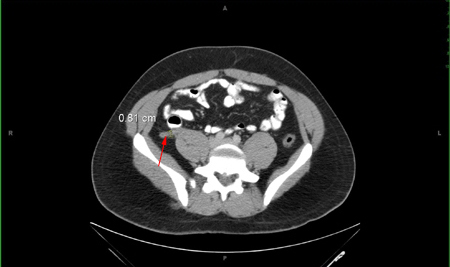Investigations
1st investigations to order
FBC
Test
Request an FBC in all patients.[27]
Use the results of initial blood tests, in combination with history and examination, to risk stratify patients using a scoring system; this will determine whether imaging is required.[7] See Risk stratification in the Diagnosis recommendations section.
Leukocytosis (10-18 x 109/L) with neutrophilia is present in 80% to 90% of adults with appendicitis.
Leukocytosis (≥16 x 109/L) and elevated CRP level (≥10 mg/L) on admission are strong predictive factors for appendicitis in children.[7]
Result
leukocytosis (10-18 x 109/L or 10,000 to 18,000/microlitre in adults; ≥16 x 109/L or 16,000/microlitre in children)
CRP
Test
Request a CRP in all patients.[27]
C-reactive protein is likely to be elevated.[9]
Elevated CRP level (≥10 mg/L) on admission and leukocytosis (≥16 x 109/L) are strong predictive factors for appendicitis in children.
In adults, use the results of initial blood tests, in combination with history and examination, to risk stratify patients using a scoring system; this will determine whether imaging is required.[7] See Risk stratification in the Diagnosis recommendations section.
Result
likely to be elevated
abdominal ultrasound
Test
If imaging is required, seek advice from a radiologist to determine the best imaging modality for your patient.
Order an ultrasound if radiation risk is a concern; it should be used as first-line in children and in pregnant women.[7][27][52][53] It is a rapid test and can be performed at the bedside.[7] Check local protocols as guidelines differ in their recommendations on use of ultrasound.
Acute appendicitis can be ruled out if a normal appendix is visualised in its full length.[7][30]
Ultrasound is also useful for detecting alternative causes of abdominal pain (e.g., gynaecological conditions).[7][27]
Order an MRI in a pregnant woman if ultrasound is inconclusive.[7][54]
Result
aperistaltic or non-compressible structure with outer diameter >6 mm
contrast-enhanced abdominal CT
Test
If imaging is required, seek advice from a radiologist to determine the best imaging modality for your patient.
Consider contrast-enhanced CT scan if:[7]
Ultrasound is inconclusive and there is ongoing clinical suspicion of appendicitis[7]
You suspect malignancy[7]
You suspect an appendicular mass or abscess.[7]
Intravenous contrast-enhanced CT scan with or without oral contrast has up to 100% sensitivity compared with 92% sensitivity in non-intravenous, contrast-enhanced CT scan.[61][63][74]
[Figure caption and citation for the preceding image starts]: CT abdomen - thickened appendixNasim Ahmed, MBBS, FACS; used with permission [Citation ends].
Result
abnormal appendix (diameter >6 mm) identified or calcified appendicolith seen in association with peri-appendiceal inflammation
Investigations to consider
urinalysis
Test
Use urinalysis to help exclude a urinary tract infection (UTI).[25]
UTI can present with very similar symptoms and signs to appendicitis.
Do not make a diagnosis of UTI on urinalysis alone. A history of urinary symptoms and urine microscopy are also required.
Be aware that urinalysis may be abnormal in about 50% of people with acute appendicitis because of inflammation adjacent to the right-sided urinary tract and bladder.[65]
Result
if positive for red cells, white cells, or nitrites, an alternative diagnosis such as renal colic or UTI should be considered
pregnancy test
Test
Test all women of childbearing age to exclude pregnancy, including ectopic pregnancy.[66]
Result
positive in pregnancy
group and save
Test
Consider a ‘group and save’ for patients having surgery.[27]
Result
for operating-theatre use
abdominal MRI
Test
If imaging is required, seek advice from a radiologist to determine the best imaging modality for your patient.
Order an MRI in a pregnant woman if ultrasound is inconclusive.[7]
In children, order MRI or CT based on local availability and expertise if there is diagnostic doubt and ultrasound is inconclusive.[7]
Result
abnormal appendix (diameter >6mm) identified and evidence of periappendiceal inflammatory changes, appendicolith, fat stranding
Emerging tests
neutrophil-to-lymphocyte ratio
serum sodium
Pentraxin-3
Test
Pentraxin-3 is an acute phase protein, which may be elevated in acute appendicitis.[70]
Result
elevated Pentraxin-3
serum amyloid A
Test
One systematic review and meta-analysis showed that serum amyloid A has a sensitivity and specificity for acute appendicitis of 0.87 and 0.74 respectively.[71]
Result
elevated serum amyloid A
Use of this content is subject to our disclaimer